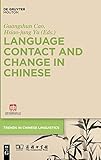Language Contact and Change in Chinese / ed. by Guangshun Cao, Hsiao-jung Yu.
Material type: TextSeries: Trends in Chinese Linguistics [TCL] ; 1Publisher: Berlin ; Boston : De Gruyter Mouton, [2019]Copyright date: ©2019Description: 1 online resource (IX, 255 p.)Content type:
TextSeries: Trends in Chinese Linguistics [TCL] ; 1Publisher: Berlin ; Boston : De Gruyter Mouton, [2019]Copyright date: ©2019Description: 1 online resource (IX, 255 p.)Content type: - 9783110610062
- 9783110610246
- 9783110612981
- 495.12 23
- PL1281 .H3513 2019eb
- online - DeGruyter
- Issued also in print.
| Item type | Current library | Call number | URL | Status | Notes | Barcode | |
|---|---|---|---|---|---|---|---|
 eBook
eBook
|
Biblioteca "Angelicum" Pont. Univ. S.Tommaso d'Aquino Nuvola online | online - DeGruyter (Browse shelf(Opens below)) | Online access | Not for loan (Accesso limitato) | Accesso per gli utenti autorizzati / Access for authorized users | (dgr)9783110612981 |
Frontmatter -- Foreword -- Contents -- List of Abbreviations -- Theory and fact – A study of the translated Buddhist scriptures of the Medieval Period from the perspective of language contact -- On the origin of the Chinese reflexive ziji from the perspective of the Medieval Chinese Buddhist scriptures -- The origin and development of negative exclusive particles in the Chinese language -- The postpositions suo 所 and bian 边 in translated Chinese Buddhist scriptures of the Medieval Period -- Variant reduplication and four-character state adjectives in Yuan Zaju -- The correlation between the Chinese purpose construction “VP + qu (去, ‘go’)” and SOV languages -- On the Han’er Yanyu of the Yuan Dynasty -- A study of the special syntactic features in Yuan baihua -- On the special syntactic features in the vernacular imperial edicts of the early Ming Dynasty (1368–1424) -- The influence of language contact on word order of some minority languages in Southern China -- Second language acquisition and contactinduced language change in the history of the Chinese language -- Postscript -- Index
restricted access online access with authorization star
http://purl.org/coar/access_right/c_16ec
The book sheds light on the fascinating evolution of contact-induced grammatical features in Chinese syntax. For more than two thousand years, Chinese has been in large scale language contact with languages such as Sanskrit, Mongolian, and Manchurian. Originally published in Chinese in renowned academic journals, the contributions are made available for the first time to the English speaking world.
Issued also in print.
Mode of access: Internet via World Wide Web.
In English.
Description based on online resource; title from PDF title page (publisher's Web site, viewed 25. Jun 2024)


